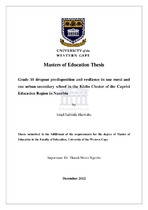| dc.description.abstract | The study investigated school dropout predisposition and resilience at Grade 10 level in one rural and one urban secondary school in the Kizito Cluster of the Caprivi Education Region in Namibia. Part of the study was by means of a literature review of studies on school dropout in different parts of the world. The review also related to theoretical explanations of school dropout predisposition and resilience, together with preceding studies about the two phenomena. The qualitative research approach was used to obtain information about participants' experiences, beliefs, and perceptions about the school dropout and resilience phenomena. The study was framed by the interpretive research paradigm. The case study method, along with semi-structured, one-on-one and focus group interviews and document analysis were used to gather data. In addition, the study was also framed by grounded theory for the purposes of identifying alignments between the study’s findings and existing theories whilst also enabling the identification of theoretical gaps regarding some the study’s findings which subsequent studies should address. In addition, grounded theory also helped to present a theoretical discussion of the two studied phenomena. Factors found to be associated with school dropout predisposition in the rural school included over-age and alcohol and drug abuse (in boys), long walking distances to school and teenage pregnancy (in girls), poor academic performance, curriculum, poverty, peer pressure and lack of parental involvement and support in the education of children( in both sexes). Factors that were found to be associated with school dropout resilience at the school included availability of role models, good academic performance, parental involvement and support in education and the teaching of the Life Skills subject. Factors found to be associated with school dropout predisposition in the urban school included curriculum, poor academic performance, over-age, poverty and peer pressure (in both sexes), alcohol and drug abuse, bullying and lack of hostel accommodation (in boys), teenage pregnancy and early marriages or involvement in sexual activities (in girls). Factors that were found to be associated with school dropout resilience at the school included good academic performance, learning from siblings and friends’ dropout experiences, self-determination and self-motivation, and valuing education and motivation from parents and relatives, counselling, praising learners and inviting renowned individuals to speak to children. Factors which were found to be linked to existing dropout predisposition theories were curriculum, poor academic performance and poverty, whilst teenage pregnancy was found not to be linked to existing theories. A factor which was found to be linked to existing dropout resilience theories was good academic performance whilst no factor was found not to be linked to existing theories. Recommendations in this study include calls for exploration by further studies in generating new theories to better explain findings in this study. The recommendations to schools and the Regional Education Directorate to help in enhancing dropout resilience include counselling and academic performance enhancing strategies. | en_US |

